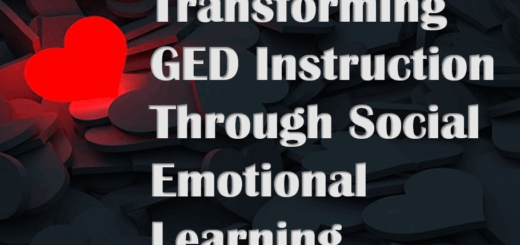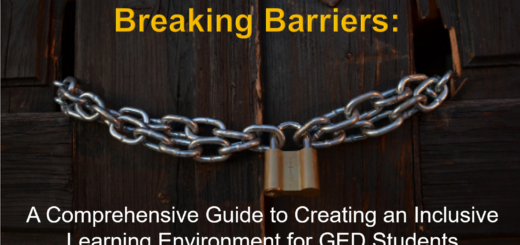Getting Adult Students out of their Seats
How do you get GED students up and out of their seats and why would you want to?
In a GED classroom, a lot of learning will happen in a traditional style, student in desk and teacher at the front of the classroom. However, there are many benefits to getting your students out of their routines, out of their desks, and involved in active learning.
Benefits:
- Moving does a body good. Blood circulation is necessary for life; in fact, there are many health risks associated with a sedentary lifestyle. In the short term and for our purposes, blood circulation means more blood to the brain, which in turn means that students’ ability to retain information increases.
- Whole Body Learning. This happens when students and teachers interact physically, mentally, and even emotionally during instruction. When the whole body is involved, retention increases. In fact, the cerebellum is the part of the brain that processes movement, AND it is also the portion of the brain responsible for memory and attention. Combine movement and memory and you have a lesson students are less likely to forget.
- Feeling part of a team. Timid students may choose a desk and work independently. Although this is okay some of the time, students are more likely to keep coming to class if they feel like they are part of a team. When students do activities together, a social bonding forms, and happy students tend to absorb more information.
- Instructional variety. Routines are great, but if those routines aren’t broken every now and then, students can get bored, and boredom can be a factor in students deciding not to come back. It seems that everyone now is on their phones. We watch content that is quick and ever changing. Because we all have become accustomed to constantly being entertained, the modern educator has a new task at hand. Now more than ever before, our lessons need to be informative as well as enjoyable.
- Laughter. Interaction often leads to laughter which increases students’ abilities to retain information. Simply put, we learn better when we are having fun. When we laugh, we make emotional connections to presented material, and as we all have been told many times before, people might forget what they see and hear, but they will never forget the way they felt. If the day’s material is associated with positive emotions, students are less likely to forget.
- Creativity. Many kinesthetic activities allow students’ creativity out to play. If all we do is put a book in front of our students, they don’t get a chance to utilize out of the box thinking. Finding creative ways to solve a puzzle, conduct a group activity, etc. allows students to use a different skill set, one that could eventually help them solve problems on the GED test.
- Reaching hands-on learners. Although some students can sit in a desk, take notes, and absorb information, others need to learn by doing. When you get students up and out of their desks, you have a chance to engage students in kinesthetic learning, reaching students who might otherwise be left behind.
- Community. Building a community in your classroom aids in student success. Students make friends, and they begin to feel that their classroom is a home away from home. They begin to not only care about their own success, but the success of their classmates so that inside and outside of class, they are more likely to ask for help from their peers when needed.
- Real-world application of skills. Some hands-on activities actually show how some of the GED material might be used in real-life situations. For instance, you might give the students tape measures and tell them that your school has decided to pay for a complete room make over, but they need some measurements in order to budget. Then, ask students to measure the walls and floors and give you their areas so the school will know how much paint and tile to buy. In this situation, you would be practicing needed GED skills, the students would be working as a team, and they would be out of their desks. It’s a win-win-win!
- Time flies. Do you remember your time in K-12 classrooms? I remember that every classroom had a clock, and I recall watching that clock wishing the bell would ring. When you facilitate hands-on activities, no one will be watching the clock. Students will be involved, and involved students don’t count the minutes until class is over.
If you get your students out of their desks, you will not regret it. Planning lessons that increase student involvement helps you, as a teacher, put your creativity to practical use. Both teachers and students will be eager for lessons and sad when the end of the day comes.





